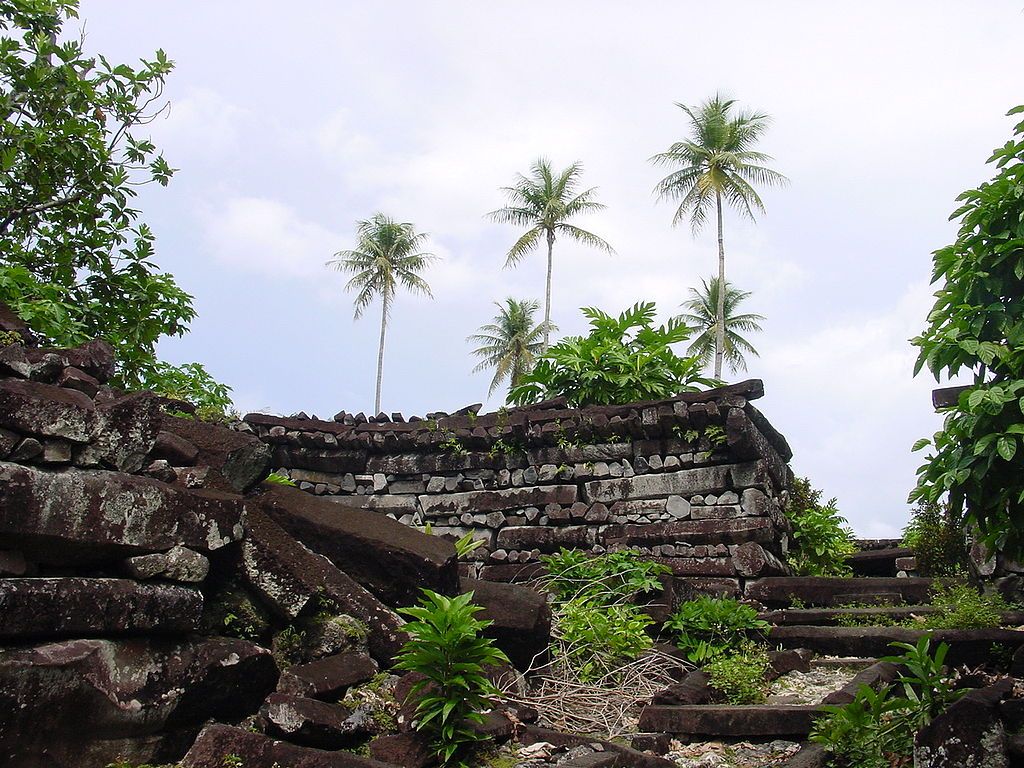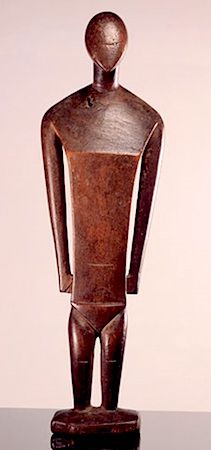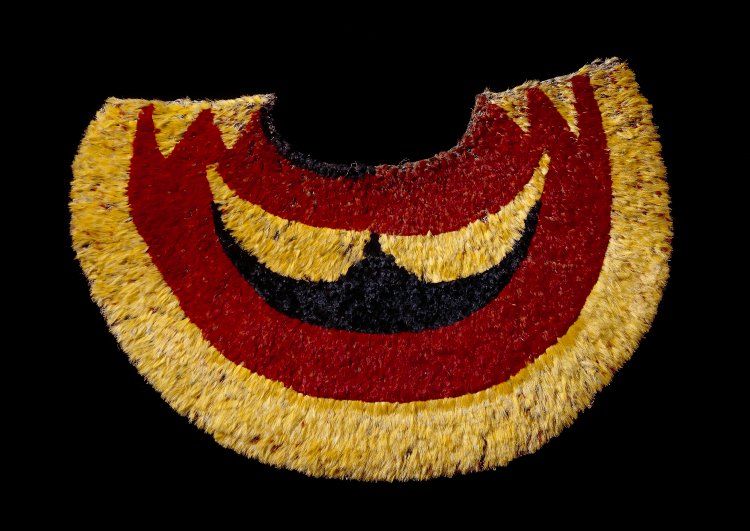Charly Castillo
Charly Castillo
AP Art History 🖼
34 resourcesSee Units
Micronesia
Nan Madol

Image Courtesy of Wikipedia (CC BY 2.0)
Form
- Basalt boulders and prism-shaped columns
- Logs arranged in a stretchers and headers pattern (similar to the post-and-lintel pattern of Units 1 and 2)
Function
- Nan Madol acted as the capital city of the Saudeleur Dynasty from approximately 1100 to 1628 CE
Content
- The city is made of 92 artificial islands, which are connected by crisscrossing canals (similar to Venice).
- Fifteen-foot-high seawalls surround the city in order to block the ocean's waves 🌊 from reaching the surface.
- Lower class citizens lived on the outskirts of the city away from people of higher status, while the upper class lived near the king 🤴 in the center. This is because the rulers didn't perceive the lower class as a threat to their power, but the upper class needed to be watched in case they were attempting to overthrow the monarchy.
Context
- The Saudeleur Dynasty fell in 1628 CE as a result of their oppressive leaders.
Female Deity from Nukuoro (Tino Aitu)

Image Courtesy of Khan Academy
Form
- Breadfruit wood
Function
- This work was used during a yearly religious ceremony as a representation of a specific deity (god or goddess in a polytheistic religion).
Content
- This figure is of a minimalistic, geometric (made of straight lines) human form. It has no identifying features such as a face 👩, and uses horizontal lines instead of more natural-appearing curves.
- Compared to European depictions of women in art, the woman depicted in this figure is much less sexualized. Her chest is broad and geometric, unlike the exaggeratedly large and curved ones of European sculpture, and she is in a stiff, erect position.
- The Female Deity may have been decorated with flowers 🌺 or garments during religious ceremonies.
Context
- The people of Nukuoro converted to Protestantism (a form of Christianity) after interacting with European traders.
Navigation Chart

Image Courtesy of Khan Academy
Form
- Wood, fiber, and assorted shells
Function
- This work was used as a map 🗺️, but was memorized before a voyage, rather than used throughout it.
Content
- The map is a type of rebbelib (Marshallese navigation chart).
- The horizontal and vertical sticks act as structural support, the diagonal lines indicate wind and water currents, and the shells 🐚 represent islands.
Context
- The people of Micronesia are well-known for their navigational skills and mapmaking, however, European colonizers saw the Marshallese as primitive and unsophisticated because of these traditions.
Hawaii
'Ahu 'ula

Image Courtesy of Khan Academy
Form
- 500,000 bird feathers, coconut fiber 🥥, and olonā (a type of plant) fiber
Function
- This 'ahu 'ula (Hawaiian feather cape) was worn by male nobility, especially well-respected, high-ranking chiefs and warriors, to protect themselves from harm.
Content
- This work is a semi-circular cape made from seven species of bird feathers: four species of ʻōʻōs, two types of mamo, ʻiʻiwi, and ʻapapane. The majority of these birds 🐤 are now extinct because they were exploited for their feathers.
Context
- Even though the cape was made in Hawaii, it was brought to England sometime in the late eighteenth century and was found there.
Cook Islands
Staff God


Images Courtesy of Khan Academy
Form
- Wood, tapa cloth, fiber, and bird feathers
Function
- Placed in a village common, the Staff God represents a deity's manava (soul), which was believed to be present everywhere in a person's life.
Content
- The work is a 12 foot-long carving of an elongated body with a large head on the top 👨 and several smaller ones carved below.
- The wooden part of this work is usually wrapped in tapa (a type of cloth made from soaked bark), which was thought to protect the spirit residing in the sculpture.
- Decorations placed inside the tapa, such as the pearl shells and red feathers, represent the soul of the deity.
- Traditionally, staff gods have a carved phallus at the end of it, but many of them were cut off by Christian missionaries. While they saw it as indecent, the native Rarotongan people saw them as a celebration of life and fertility.
Context
- Many of these staff gods were destroyed after the Rarotongans were converted to Christianity ⛪ by European missionaries.
Niue
Hiapo (Tapa) from Niue

Image Courtesy of Khan Academy
Form
- Intricately decorated tapa cloth
Function
- Before cotton started to be imported to Niue, tapa was traditionally worn as clothing or used in ceremonies and signified the wealth 💵 of its owner.
- Each individual tapa has a meaning, such as commemorating an important event or remembering an ancestor 👴
Content
- The hiapo (Niuean word for tapa) is covered in symbolic designs that represent the wealth of its owner, their importance in society, and environmental surroundings.
Context
- Hiapo are traditionally made by women.
New Zealand
Tamati Waka Nene

Image Courtesy of Khan Academy
Form
- Oil paint on canvas
Function
- Painter Gottfried Lindauer made this work to commemorate Māori (native group of New Zealand) chief Tamati Waka Nene.
Content
- Since the painter was Czech and incorporated traditionally European techniques like oil painting 🖌️ and realistic shadowing, this work is much more European in appearance than the other works in this unit.
- Lindauer depicts Tamati Waka Nene's prestige by picturing him with Māori symbols of status: a kahu kiwi (kiwi feather cloak), pounamu (type of green stone) earring, tewhatewha (weapon), and moko (face tattoo).
Context
- The subject of this painting Tamati Waka Nene is remembered for converting to the Wesleyan faith of British settlers and making peace ☮️ with them in the Treaty of Waitangi.
Papua New Guinea
Malagan Mask

Image Courtesy of Davis Publications
Form
- Wood, pigment, fiber, and shell
Function
- Malagan masks were used at funerals to ensure that the souls of the deceased would make it to the afterlife. After the ceremony, they were usually destroyed or allowed to decay 🥀.
Content
- The mask is painted black, red, and yellow, which are important colors to the people of Papua New Guinea since they represent violence, magic, and war.
- Malagan masks are not meant to be physical portraits of the deceased, but they do have human characteristics 👨 like hair, teeth, and faces.
Context
- Malagan ceremonies are traditionally performed by the native people of New Ireland, one of Papua New Guinea's provinces.
Australia
Buk (Mask)

Image Courtesy of the Metropolitan Museum of Art
Form
- Turtle shell, wood, fiber, cassowary feathers, and shell
Function
- These buk masks are traditionally worn by men in death, fertility, and male initiation ceremonies.
- Because they combine human and animal forms, buk masks are also used to show humans' connection to nature and ensure a successful, bountiful hunting season ( ⬅️ this is a major theme in unit 1 too).
- The work may have also been made to commemorate an ancestor or a mythological, supernatural creature.
Content
- These masks were part of an outline that performers would wear during ceremonies, including a grass skirt.
- The creator of this work may have used bird feathers to represent the animals's strength 💪and bravery.
Context
- Turtle shell 🐢 masks are unique to the native people of the islands in the Torres Strait (the body of water that separates Papua New Guinea from Australia).
Fiji
Presentation of Fijian Mats and Tapa Cloths to Queen Elizabeth II

Image Courtesy of Khan Academy
Form
- Photograph of a multimedia performance
Function
- The purpose of this photo 📸 is to document what happened during Queen Elizabeth II's arrival to Fiji in her 1953-54 royal tour.
Content
- Pictured in the photo is a line of women entering with tapa mats in their arms, which they are going to give to Queen Elizabeth II. In Fijian culture, tapa is gifted 🎁 during important events like weddings and funerals, which shows how much the Fijians respected their Queen.
Context
- Fiji didn't gain independence from Great Britain until 1970, which was 13 years after Queen Elizabeth II visited the nation.
Easter Island (Rapa Nui)
Moai on Platform (ahu)

Image Courtesy of Wikipedia (CC BY 2.5).
Form
- Volcanic tuff figures on a basalt base
Function
- The statues were built to represent and appreciate deceased ancestors ( ⬅️ this is a very important function seen throughout this unit).
Content
- The moai (stone sculptures) have prominent foreheads, large noses, and elongated ears 🗿 and once had designs painted on them, but those have since worn away.
- All of the statues have their backs turned towards the ocean because they are believed to be looking over the island and protecting it.
Context
- Easter Island (Rapa Nui) is considered the easternmost part of Polynesia, and it is closer to South America than Asia, unlike most of the other Pacific islands. Because of this unusual geography, Chile extended its power to Rapa Nui, and the island is now a part of that nation.
And that's a wrap! Hopefully, this unit guide comes in handy as you study for the AP Art History exam.
Browse Study Guides By Unit
🗿Unit 1 – Global Prehistoric Art, 30,000-500 BCE
🏛Unit 2 – Ancient Mediterranean Art, 3500-300 BCE
⛪️Unit 3 – Early European and Colonial American Art, 200-1750 CE
⚔️Unit 4 – Later European and American Art, 1750-1980 CE
🌽Unit 5 – Indigenous American Art, 1000 BCE-1980 CE
⚱️Unit 6 – African Art, 1100-1980 CE
🕌Unit 7 – West and Central Asian Art, 500 BCE-1980 CE
🛕Unit 8 – South, East, and Southeast Asian Art, 300 BCE-1980 CE
🐚Unit 9: The Pacific, 700–1980 ce
9.2Regions
- Staff god
- Buk (mask)
- Tamati Waka Nene
- Navigation chart
- Presentation of Fijian mats and tapa cloths to Queen Elizabeth II
- Micronesia 🇫🇲 🇲🇭
- Nan Madol
- Female Deity from Nukuoro (Tino Aitu)
- Navigation Chart
- Hawaii 🇺🇸
- 'Ahu 'ula
- Cook Islands 🇨🇰
- Staff God
- Niue 🇳🇺
- Hiapo (Tapa) from Niue
- New Zealand 🇳🇿
- Tamati Waka Nene
- Papua New Guinea 🇵🇬
- Malagan Mask
- Australia 🇦🇺
- Buk (Mask)
- Fiji 🇫🇯
- Presentation of Fijian Mats and Tapa Cloths to Queen Elizabeth II
- Easter Island (Rapa Nui) 🇨🇱
- Moai on Platform (ahu)
🏢Unit 10 – Global Contemporary Art, 1980 CE to Present
🙏Exam Reviews

© 2023 Fiveable Inc. All rights reserved.